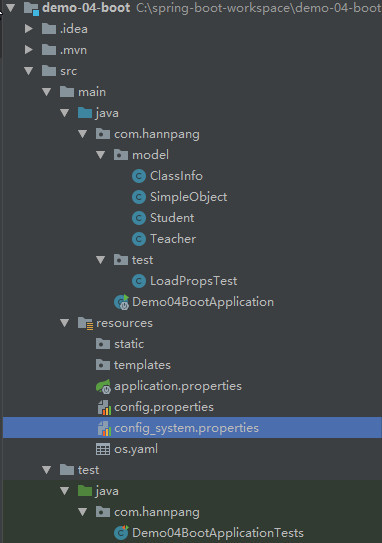关于注入数据说明

1.不通过配置文件注入数据
通过@value将外部的值动态注入到bean中,使用的情况有:
- 注入普通字符串
- 注入操作系统属性
- 注入表达式结果
- 注入其他bean属性:注入student对象的属性name
- 注入文件资源
- 注入url资源
辅助代码
|
1
2
3
4
5
6
7
8
9
10
11
12
13
14
15
16
17
18
|
package com.hannpang.model;import org.springframework.beans.factory.annotation.value;import org.springframework.stereotype.component;@component(value = "st")//对student进行实例化操作public class student { @value("悟空") private string name; public string getname() { return name; } public void setname(string name) { this.name = name; }} |
测试@value的代码
|
1
2
3
4
5
6
7
8
9
10
11
12
13
14
15
16
17
18
19
20
21
22
23
24
25
26
27
28
29
30
31
32
33
34
35
36
37
38
39
40
41
42
43
44
45
46
|
package com.hannpang.model;import org.springframework.beans.factory.annotation.value;import org.springframework.core.io.resource;import org.springframework.stereotype.component;@componentpublic class simpleobject { @value("注入普通字符串") private string normal; //关于属性的key可以查看system类说明 @value("#{systemproperties['java.version']}")//-->使用了spel表达式 private string systempropertiesname; // 注入操作系统属性 @value("#{t(java.lang.math).random()*80}")//获取随机数 private double randomnumber; //注入表达式结果 @value("#{1+2}") private double sum; //注入表达式结果 1+2的求和 @value("classpath:os.yaml") private resource resourcefile; // 注入文件资源 @value("http://www.baidu.com") private resource testurl; // 注入url资源 @value("#{st.name}") private string studentname; //省略getter和setter方法 @override public string tostring() { return "simpleobject{" + "normal='" + normal + '\'' + ", systempropertiesname='" + systempropertiesname + '\'' + ", randomnumber=" + randomnumber + ", sum=" + sum + ", resourcefile=" + resourcefile + ", testurl=" + testurl + ", studentname='" + studentname + '\'' + '}'; }} |
spring的测试代码
|
1
2
3
4
5
6
7
8
9
10
11
12
13
14
15
16
17
18
19
20
21
|
package com.hannpang;import com.hannpang.model.simpleobject;import org.junit.test;import org.junit.runner.runwith;import org.springframework.beans.factory.annotation.autowired;import org.springframework.boot.test.context.springboottest;import org.springframework.test.context.junit4.springrunner;@runwith(springrunner.class)@springboottestpublic class demo04bootapplicationtests { @autowired private simpleobject so; @test public void contextloads() { system.out.println(so); }} |
运行结果为:simpleobject{normal='注入普通字符串', systempropertiesname='1.8.0_172', randomnumber=56.631954541947266, sum=3.0, resourcefile=class path resource [os.yaml], testurl=url [http://www.baidu.com], studentname='悟空'}
2.通过配置文件注入数据
通过@value将外部配置文件的值动态注入到bean中。配置文件主要有两类:
- application.properties、application.yaml application.properties在spring boot启动时默认加载此文件
- 自定义属性文件。自定义属性文件通过@propertysource加载。@propertysource可以同时加载多个文件,也可以加载单个文件。如果相同第一个属性文件和第二属性文件存在相同key,则最后一个属性文件里的key启作用。加载文件的路径也可以配置变量,如下文的${anotherfile.configinject},此值定义在第一个属性文件config.properties
在application.properties中加入如下测试代码
|
1
|
app.name=一步教育 |
在resources下面新建第一个属性文件config.properties内容如下
|
1
2
|
book.name=西游记anotherfile.configinject=system |
在resources下面新建第二个属性文件config_system.properties内容如下
我的目的是想system的值使用第一个属性文件中定义的值
|
1
|
book.name.author=吴承恩 |
下面通过@value(“${app.name}”)语法将属性文件的值注入bean属性值,详细代码见:
|
1
2
3
4
5
6
7
8
9
10
11
12
13
14
15
16
17
18
19
20
21
22
23
24
25
26
27
28
29
30
31
32
33
34
35
36
37
38
39
40
41
42
43
44
45
|
package com.hannpang.test;import org.springframework.beans.factory.annotation.autowired;import org.springframework.beans.factory.annotation.value;import org.springframework.context.annotation.propertysource;import org.springframework.core.env.environment;import org.springframework.stereotype.component;@component@propertysource(value = {"classpath:config.properties","classpath:config_${anotherfile.configinject}.properties"})public class loadpropstest { @value("${app.name}") private string appname; // 这里的值来自application.properties,spring boot启动时默认加载此文件 @value("${book.name}") private string bookname; // 注入第一个配置外部文件属性 @value("${book.name.author}") private string author; // 注入第二个配置外部文件属性 @autowired private environment env; // 注入环境变量对象,存储注入的属性值 //省略getter和setter方法 public void setauthor(string author) { this.author = author; } @override public string tostring(){ stringbuilder sb = new stringbuilder(); sb.append("bookname=").append(bookname).append("\r\n") .append("author=").append(author).append("\r\n") .append("appname=").append(appname).append("\r\n") .append("env=").append(env).append("\r\n") // 从eniroment中获取属性值 .append("env=").append(env.getproperty("book.name.author")).append("\r\n"); return sb.tostring(); }} |
测试代码
|
1
2
3
4
5
6
7
8
9
10
11
12
13
14
15
16
17
18
19
20
21
22
23
|
package com.hannpang;import com.hannpang.model.simpleobject;import com.hannpang.test.loadpropstest;import org.junit.test;import org.junit.runner.runwith;import org.springframework.beans.factory.annotation.autowired;import org.springframework.boot.test.context.springboottest;import org.springframework.test.context.junit4.springrunner;@runwith(springrunner.class)@springboottestpublic class demo04bootapplicationtests { @autowired private loadpropstest lpt; @test public void loadpropertiestest() { system.out.println(lpt); }} |
运行结果为:
bookname=西游记
author=吴承恩
appname=一步教育
env=standardenvironment {activeprofiles=[], defaultprofiles=[default], propertysources=[configurationpropertysourcespropertysource {name='configurationproperties'}, mappropertysource {name='inlined test properties'}, mappropertysource {name='systemproperties'}, originawaresystemenvironmentpropertysource {name='systemenvironment'}, randomvaluepropertysource {name='random'}, origintrackedmappropertysource {name='applicationconfig: [classpath:/application.properties]'}, resourcepropertysource {name='class path resource [config_system.properties]'}, resourcepropertysource {name='class path resource [config.properties]'}]}
env=吴承恩
3. #{...}和${...}的区别演示
a .${…}的用法
{}里面的内容必须符合spel表达式,通过@value(“${app.name}”)可以获取属性文件中对应的值,但是如果属性文件中没有这个属性,则会报错。可以通过赋予默认值解决这个问题,如@value("${app.name:胖先森}")
部分代码
|
1
2
3
4
5
6
7
|
// 如果属性文件没有app.name,则会报错// @value("${app.name}")// private string name;// 使用app.name设置值,如果不存在则使用默认值@value("${app.name:胖先森}")private string name; |
b.#{...}的用法
部分代码直接演示
|
1
2
3
4
5
6
7
|
// spel:调用字符串hello world的concat方法@value("#{'hello world'.concat('!')}")private string helloworld;// spel: 调用字符串的getbytes方法,然后调用length属性@value("#{'hello world'.bytes.length}")private string helloworldbytes; |
c.#{...}和${...}混合使用
${...}和#{...}可以混合使用,如下文代码执行顺序:通过${server.name}从属性文件中获取值并进行替换,然后就变成了 执行spel表达式{‘server1,server2,server3'.split(‘,')}。
|
1
2
3
|
// spel: 传入一个字符串,根据","切分后插入列表中, #{}和${}配置使用(注意单引号,注意不能反过来${}在外面,#{}在里面)@value("#{'${server.name}'.split(',')}")private list<string> servers; |
在上文中在#{}外面,${}在里面可以执行成功,那么反过来是否可以呢${}在外面,#{}在里面,如代码
|
1
2
3
|
// spel: 注意不能反过来${}在外面,#{}在里面,这个会执行失败@value("${#{'helloworld'.concat('_')}}")private list<string> servers2; |
答案是不能。
因为spring执行${}是时机要早于#{}。
在本例中,spring会尝试从属性中查找#{‘helloworld'.concat(‘_')},那么肯定找到,由上文已知如果找不到,然后报错。所以${}在外面,#{}在里面是非法操作
d.用法总结
- #{…} 用于执行spel表达式,并将内容赋值给属性
- ${…} 主要用于加载外部属性文件中的值
- #{…} 和${…} 可以混合使用,但是必须#{}外面,${}在里面
4.@value获取值和@configurationproperties获取值比较
| @configurationproperties | @value | |
|---|---|---|
| 功能 | 批量注入配置文件中的属性 | 一个个指定 |
| 松散绑定(松散语法) | 支持 | 不支持 |
| spel | 不支持 | 支持 |
| jsr303数据校验 | 支持 | 不支持 |
| 复杂类型封装 | 支持 | 不支持 |
配置文件yml还是properties他们都能获取到值;
- 如果说,我们只是在某个业务逻辑中需要获取一下配置文件中的某项值,使用@value;
- 如果说,我们专门编写了一个javabean来和配置文件进行映射,我们就直接使用@configurationproperties;
关于数据校验的部分代码
|
1
2
3
4
5
6
7
|
@component@configurationproperties(prefix = "person")@validatedpublic class person { //lastname必须是邮箱格式 @email private string lastname; |
5. @importresource引入配置文件
不推荐的使用方式
spring boot里面没有spring的配置文件,我们自己编写的配置文件,也不能自动识别;
想让spring的配置文件生效,加载进来;@importresource标注在一个配置类上
|
1
2
|
@importresource(locations = {"classpath:beans.xml"})导入spring的配置文件让其生效 |
编写配置文件信息
|
1
2
3
4
5
6
|
<?xml version="1.0" encoding="utf-8"?><beans xmlns="http://www.springframework.org/schema/beans" xmlns:xsi="http://www.w3.org/2001/xmlschema-instance" xsi:schemalocation="http://www.springframework.org/schema/beans http://www.springframework.org/schema/beans/spring-beans.xsd"> <bean id="helloservice" class="com.hanpang.springboot.service.helloservice"></bean></beans> |
大概了解就好,我们基本上不使用这种方式
6.@configuration注解
springboot推荐给容器中添加组件的方式;推荐使用全注解的方式
1、配置类@configuration作用于类上,相当于一个xml配置文件
2、使用@bean给容器中添加组件,作用于方法上
|
1
2
3
4
5
6
7
8
9
10
11
12
13
14
15
16
|
/** * @configuration:指明当前类是一个配置类;就是来替代之前的spring配置文件 * * 在配置文件中用<bean><bean/>标签添加组件 * <bean id="helloservice" class="com.hanpang.springboot.service.helloservice"></bean> */@configurationpublic class myappconfig { //将方法的返回值添加到容器中;容器中这个组件默认的id就是方法名 @bean public helloservice helloservice02(){ system.out.println("配置类@bean给容器中添加组件了..."); return new helloservice(); }} |
使用bean注入太麻烦,我们更加喜欢使用扫描的方式
|
1
2
3
4
5
6
7
8
9
10
11
12
13
14
15
16
17
18
19
20
21
22
|
import org.springframework.context.annotation.bean;import org.springframework.context.annotation.componentscan;import org.springframework.context.annotation.configuration; import com.wx.dao.iuserdao;import com.wx.dao.userdaoimpl; //通过该注解来表明该类是一个spring的配置,相当于一个传统的applicationcontext.xml@configuration//相当于配置文件里面的<context:component-scan/>标签,扫描这些包下面的类的注解@componentscan(basepackages="com.hanpang.dao,com.hanpang.service")public class springconfig { // 通过该注解来表明是一个bean对象,相当于xml中的<bean> //bean的id值默认是方法名userdao /* @bean public helloservice helloservice02(){ system.out.println("配置类@bean给容器中添加组件了..."); return new helloservice(); } */} |
附录
随机数
|
1
2
|
${random.value}、${random.int}、${random.long}${random.int(10)}、${random.int[1024,65536]} |
以上就是本文的全部内容,希望对大家的学习有所帮助,也希望大家多多支持服务器之家。
原文链接:https://segmentfault.com/a/1190000017485165















